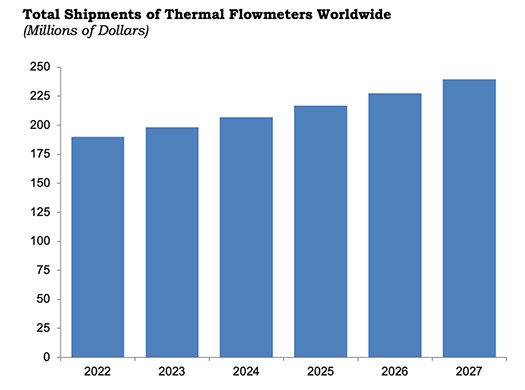September 2023, Vol. 250, No. 9
Features
Study Finds Growth Within Thermal Flowmeter Market
Special to P&GJ
(P&GJ) — Thermal flowmeters are riding the surge of gas flow measurement in both renewable and traditional natural gas applications, according to a new study from Flow Research, “The World Market for Thermal Flowmeters.”
The study found that the worldwide thermal flowmeter market totaled $190 million in 2022 and is projected to increase at a compound annual growth rate (CAGR) of 4.7%r through 2027.
The anticipates multipoint thermal meter revenues to grow faster than the inline and single-point insertion types of meters. Landfill gas and biogas recovery is identified as the fastest growing applications for thermal meters, with biomass fermentation and recovery seen as growing the second fastest.
“The future of gas measurement is extremely promising,” said Dr. Jesse Yoder, president of Flow Research, a metering research company. “Natural gas is no longer just a bridge to renewables. It is a renewable. As biogas and biogenic methane become more and more mainstream, new opportunities in gas flow measurement are multiplying, and thermal technology is well positioned to take advantage of that trend.”
Wide Ranging
Thermal mass flowmeter technology designs vary more by industry and specific fluid applications than most other types of meters. Important selection factors include the type of gas to be measured, low or high flow conditions, sensor material, approvals, measuring accuracy, available diameters, and pressure and temperature tolerances.
Thermal flowmeters, used almost entirely for air and gas flow measurement, are found in a wide range of industries, including oil & gas, chemical, power, and water and wastewater. Applications include flare stacks, nuclear plants, automobile testing lines, natural gas submetering, gasification plants, and compressed air systems. They are used in both traditional and renewable natural gas measurement, including biogas production and creating syngas (synthesis gas.
Frontiers in Development
Thermal flowmeters are cost-effective and versatile, respond quickly, and excel at measuring flow at low flow-rates, , according to Flow Research. They offer value, high turndown ratio, cost-effectiveness in large line sizes, flexibility for a wide range of gases and high repeatability.
One limitation of thermal flowmeters is that they are used almost entirely for gas flow measurement because of the slow response time involved in using the thermal principle on liquids. Thermal flowmeters need to be calibrated on the type of gas they are measuring, and they need to be calibrated periodically.
Condensed moisture in the gas can reduce measurement accuracy, and changes in gas composition can affect measurement accuracy. These limitations are the focus of product development by many thermal suppliers.
A bright spot for thermal meters is multipoint meters, which traditionally have been used to measure flow in large ducts and stacks and are now being used in other applications and smaller line sizes.
Greater accuracy can be derived from multiple measuring points. Other enhancements that also improve accuracy include flow conditioners, smart meters and user-programmable meters that can accommodate changing gas requirements.
Hot-Wire Anemometers
The roots of thermal flowmeters go back to the hot-wire anemometers that were used for velocity profile and turbulence research in airflow measurement in the 1960s. Hot-wire anemometers are based on the principle that a heated wire cools as wind passes over it.
The anemometer calculates the wind speed based on the heat loss of the wire. Hot wire anemometers have a quick response time but are too fragile for industrial environments.
Thermal flowmeters were first introduced for industrial applications in the 1970s after Jerome Kurz and John Olin developed an industrialized version of the hot-wire anemometer. Together they formed Sierra Instruments in 1973. Kurz formed Kurz Instruments in April 1977 and it became the first company to bring industrial thermal flowmeters to market.
Fluid Components International (FCI), founded in 1964, developed flow switches to detect the flow of oil through pipes in the oil patch. In 1981, FCI created thermal flowmeters for measuring gas flow by adding more electronics to its switches. A second generation of suppliers appeared in the 1980s and 1990s.
Thermal flowmeters compute mass flow by measuring the effects of cooling on the flowstream, based on the principle that higher velocity flows result in greater cooling. Thermal meters introduce heat into the flowstream and measure how much heat dissipates using one heated sensor and a second sensor that measures the temperature of the flowstream.






Comments